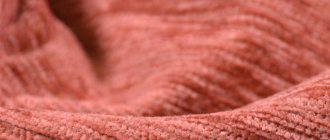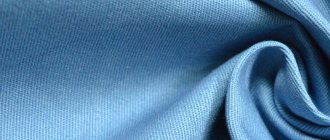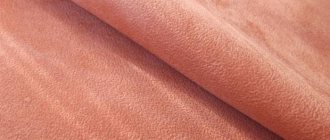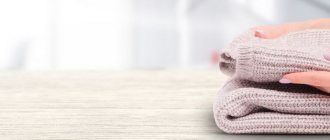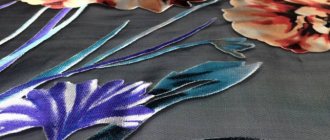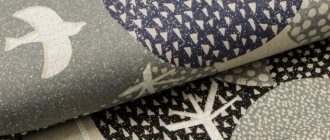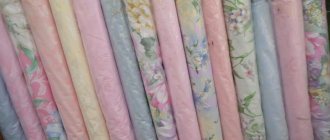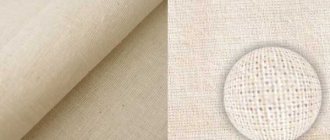Today there are many fabrics of different structures, colors and shapes on the market. Each type of material, for example, satin, tulle, silk, cotton, has its own purpose.
It can be used for sewing clothes, interior decoration, at home, etc. This article discusses quilted fabric, which is most often used to make blankets, pillows, mattresses, and bed linen.
The meaning of quilting material
What is quilted fabric
Many housewives often wonder what quilted fabrics are? This material consists of several (most often three) layers: two outer layers and a filler between them. All layers are fastened together throughout the entire area of the canvas.
On padding polyester
Bulk fiber is usually used as a filler, for example, padding polyester, cotton wool or batting, bamboo fibers, thermal membrane or other materials, depending on the required properties of the material.
There can be more than one inner layers, for example, padding polyester can be supplemented with a layer of down, artificial or natural fur, a thermal membrane or moisture-wicking fabric.
Quilted material on padding polyester
However, most often a single layer of filler is used. Therefore, quilted fabric made on padding polyester turns out to be quite soft.
History of the fabric
It is believed that quilted material first appeared in Ancient China, where it was used to sew silk kimonos or capes. Like other innovations, quilting spread to neighboring countries and then reached Europe.
During the Crusades, knights used quilted clothing to protect their bodies from the cold, as well as the heaviness and rigidity of their armor.
Note! Polycotton ceases to be exclusively utilitarian. Each stitch on padding polyester acquires the character of decoration; it is made with contrasting threads and decorated with cords.
When did fabric first appear?
Quilted padding polyester was produced in the form of light, warm blankets. Multi-colored pieces of fabric collected into one cloth were quilted by hand; cotton fibers, wool, and even dried grass were placed inside the blankets. This fabric was actively used for sewing clothes and household items. It makes an excellent quilted jacket, horse cape, bedspread, furniture cover.
You might be interested in this Description of the properties, characteristics and appearance of guipure fabric in different colors
Material cutting
The main lining fabric and synthetic padding layer are cut to the same dimensions. Making some details more or less is labor-intensive and unnecessary work.
Note! The main fabric is cut strictly along the thread. The required size is measured along the edge of the fabric, an incision is made, and then the thread must be carefully pulled out. The canvas is cut strictly according to the resulting puff.
You might be interested in this All about fabric roller blinds on internal and external windows
Cut the fabric thread by thread
If the upper part of the blanket is sewn from several parts, then all its parts are cut out, assembled into a single whole according to the pattern, and then the lining and interlayer are cut strictly according to the dimensions of the front side. The synthetic padding filler, consisting of two strips, is swept away manually with thread before cutting.
Characteristics and properties of quilted materials
Ultrastep is a method of producing quilted materials without the use of threads; the joining of fabrics is carried out using ultrasound. Just as once upon a time all duplicating machines began to be called copiers after the trademark of the company that produced them, so ultrastep in Russia got its name, which a little more than ten years ago became a pioneer in the production of new fabrics.
Characteristics of matter
When figuring out why quilted ultrastep is good, you need to know what it is made of. Ultrastep technology, or thermal stitching, is the effect of ultrasound on textile fibers. A prerequisite for its use is the presence of synthetic threads, the proportion of which must be at least 30%. Under the influence of ultrasound, they are melted and then securely fastened to each other. The advantages of this connection method are the absence of punctures of the canvas, resulting in:
- insulation fibers do not move and do not penetrate into the resulting holes;
- the integrity of matter is not violated;
- The quilted product retains its appearance even after repeated washing.
Features of the technology
The main areas of application of materials quilted using ultrasound are:
- blankets, mattresses, pillows;
- decorative bedspreads, blankets, children's “envelopes”;
- warm clothes and hats;
- bags and other accessories;
- upholstery for furniture.
Ultrastep consists of three layers, which are selected depending on the purpose of the products. For bedding, microfiber, polycotton, satin or satin are used for the top, and polyester fibers, fiber, shervizin, and “swan’s down” based on polyester are used as filler. In decorative textiles, the top layer can be satin, satin, jacquard, tergalet and other elegant fabrics.
Types and uses of ultrastep
As for quilted fabric for outerwear, synthetic jacket material is usually chosen for the outer covering, and fleece, rayon, or microfiber are used as the lining. A lining is also required, which most often consists of padding polyester, sherstepon, Thinsulate, or ecofiber. They make durable and comfortable clothing.
Unique properties
Today, there are several ways to industrially produce quilted fabric. Depending on the stitching method, the following types can be distinguished:
- Stitching fabric with threads. This is a classic, familiar type of stitch. It is performed with threads that stitch through all layers of material and form a pattern on the fabric;
- Ultrasonic stitching. A modern type of stitching in which the layers are joined using ultrasound. The seams are very durable, and with this production method there is no need for threads, shuttles, needles and other sewing paraphernalia;
- Thermal stitching or stitching using high temperatures. Layers of material are compressed in special presses with convex patterns heated to high temperatures, which melt the fabric fibers and solder them together. This stitching method is only suitable for synthetic materials.
You might be interested in what is PVC coated awning fabric
Important! Today, the use of quilted fabric is very wide. It is used to make sports and casual outerwear: jackets, coats, parkas, vests, overalls and trousers. Quilted fabric has even come into high fashion - designers offer quilted skirts, dresses and jackets. A more common use of quilted fabric is in the production of bedspreads and blankets.
How to connect pieces of padding polyester together. How to sew a blanket from padding polyester or holofiber
How to sew a blanket with your own hands.
And what is it for...Brilliant idea! Despite the fact that I am a dressmaker and have never experienced a shortage of bedding, this topic suddenly became relevant to me. Now I’ll tell you why. Our washing machines are able to gently wash and wring a blanket almost dry. And modern materials, in turn, make it possible to do this. After all, you can’t wash a cotton or down blanket, right... And these blankets are being forced out of our lives by lighter, more comfortable, hygienic blankets, of which there are a great variety on sale for every taste and budget. Why then sew a blanket with your own hands? - you say. I'll tell you... how to sew - at the end of the article. I suddenly realized that a pile of duvet covers every week stresses me out: take them off, put them on, wash them, iron them, put them in piles, store them
And each blanket needs its own duvet covers.
Isn’t it easier, I thought, to sew a couple of blankets (so that there is a change) and come with sheets and pillowcases. I think this is brilliant! Both me and my family really enjoyed it!
This solves several problems at once. Duvet covers do not need to be ironed. And instead of stacks of duvet covers, you'll just have one more blanket to spare. It doesn't need to be ironed. I threw it in the machine, washed it, dried it, and folded it.
Regarding aesthetics. Personally, I like simple things. To do this, you just need to choose the right fabric - to suit your taste, to suit the interior, etc... But if for someone it is important that it has edgings, frills, frills, then this is a matter of technology. Even if you have to iron them, it’s still easier than struggling with the duvet cover.
Where should I put my “favorite” duvet covers? - you say. And then everything is simple - turn them into blankets and your sets are ready!
I did my first experiment on a baby blanket when my little granddaughter was visiting me. By the way, this is especially convenient for children: if an incident occurs at night, you can simply wash the entire set along with the blanket.
Draw conclusions. You probably won't agree with me right away, but the thought will stick in your head until it overcomes your habits. In the meantime, I’ll show you how to sew a blanket with your own hands using the example of what I sewed for my 79-year-old mother. Our blanket has finished dimensions of 145x195 cm
Here are the materials I needed: satin - 3 meters, holofiber or siliconized padding polyester (100 grams) - 4 meters, thread
Equipment: sewing machine, scissors, tailor's pins, safety pins (those used to pull through elastic bands and laces), long ruler, chalk, measuring tape.
1. I recommend and insist that if you want to sew a truly soulful soft light blanket, buy satin for the top of the blanket or use a not shabby, but pleasant to the touch, soft and also light duvet cover (just not the one that warped after the first wash) Why exactly? satin With its beautiful smooth surface, satin, thanks to its weave, is wear-resistant and easy to wrinkle. This is natural 100% cotton fabric.
2. Holofiber or padding polyester. If you buy 200 or 300 gram material, then one blanket length is enough for you. With 100 grams you will have to lay 2 layers, it’s more difficult, but better! Note: if you perform your experiment on a duvet cover, then choose one that has a cut for tucking the blanket on one of the sides. A duvet cover with a shaped cutout in the middle will not work.
All is ready? You can start sewing your quilt!
The traditional Sampler blanket consists of three layers: a patchwork top, a lining, and an interlining.
For a patchwork top, it is extremely important to select as accurately as possible the background that unites all the elements and colors (sometimes called binding). The background should not stand out, not break out of the composition, but should set off and collect the color and shape of your square inserts. Dark frames look good. Or, conversely, light.
The finished squares are first sewn together, connecting with short vertical sections of the background. Then the resulting stripes are stitched with the horizontal stripes of the background into a single rectangular fabric. As a rule, a border is made from the background fabric (but it can also be made from contrasting fabric), which is stitched around the perimeter.
The lining can be made from the same or any other fabric of your choice. Sometimes they make a double-sided blanket, and then the lining is also sewn from patchwork geometric squares, assembled into blocks on the background. In this option, you can “play” with color and make, for example, a mirror image of the front top: light blocks on a dark background, dark ones on a light one.
If the fabrics are very thin, then a piece of fabric (not necessarily new) is inserted between the base and the interfacing and all three pieces of fabric are quilted by hand or by machine. You can sew braid on top of the seams or make an additional appliqué and quilt the blanket along with it. In order for the blanket to look good and look neat, it is very important to follow the direction of the pattern of the background fabric, especially if the pattern is a square or polka dot.
To give the blanket volume, it is first stitched along the contour (grabbing all three layers of the product), and then an incision is made on the back side of the lining and, carefully straightening it, a filling material (non-woven fabric, padding polyester) is placed. The incision is then sewn together by hand. If a volumetric technique is used, the lining should be made of durable fabric.
Assembling a large blanket
Assembly of large, bulky products presents certain difficulties. In a one-room apartment, sewing a two-meter-sized blanket is not easy - there is no room to turn around. Then the blanket is divided into blocks and sewn together in parts. Seams for strength are sewn with a stitch “in the seam”, and then from above – with a “zigzag” end-to-end.
Machine stitch "zigzag" butt
But first, each block is quilted separately along with the padding polyester and lining, leaving large seam allowances for all three components (lining, padding polyester, patchwork top). Moreover, the lining and padding polyester should be larger in size than the patchwork top. Then they begin to assemble the blanket.
The patchwork top is laid face down on the floor, the edges are taped to the floor to prevent the fabric from fidgeting. First, the patchwork top is sewn on the blocks, then the padding polyester is carefully straightened. To prevent unnecessary thickenings from forming on the gasket, the pieces of synthetic padding are not sewn together, but are placed with their edges one on top of the other and the edges at the seam are split by hand. Once the two top pieces are neatly joined, the lining is sewn together using a blind stitch.
This assembly makes it possible to apply a beautiful and neat stitch (it is more convenient to do it on blocks than on a large canvas) and significantly speeds up your work.
I am glad that mine and his use in patchwork sewing found a response in the hearts of needlewomen.
This material has its supporters, as well as those who prefer to work with other fillers.
But if the choice of filler for a blanket or other patchwork product has settled on padding polyester, then it would be nice to take into account its features and know the intricacies of working with it.
- First of all, you need to make sure that none of your relatives, friends, or those to whom you are going to give your patchwork creation are allergic to it.
- For the patchwork top and back of your product, we use fabric with a dense weave of threads. So that the padding polyester is guaranteed to remain inside the product.
- We do not sew from padding polyester those things that will come into contact with hot objects - oven mitts, hot pads, etc.
- For patchwork products we use not very thick padding polyester. At least at first. Let its thickness be no more than 1-1.5 cm (grade 100 and 150, respectively).
- It is better to steam the synthetic winterizer with an iron to the other layers of the patchwork “pie”. That is, put it between the patchwork top and the back and lightly go over it with a hot iron and steam. The top layer of padding polyester will melt slightly and “stick” to the fabric. With this we immediately “kill two birds with one stone”: we will reduce the likelihood of padding polyester fibers coming out through the fabric and in small products we will be able to do without first chopping off the layers of the patchwork “pie” before stitching.
- Sintepon can be placed in the product in several layers - in some places - to give special splendor where it is needed according to the author's idea.
- The filling in the product can generally be made composite, from several layers of different materials, and the padding polyester can be placed in the middle of the “pie”. This way you won’t have to steam it, and you can “play” with the relief of the product while stitching.
- For reasons of practicality, for such products on which something is supposed to be placed later - table runners, plate covers, decorative napkins - we use only steamed, and therefore flattened, padding polyester.
- Sintepon is good for sewing patchwork panels that will not be used as intensively, such as patchwork quilts.
Regardless of patchwork sewing, padding polyester can also be used.
I want to say a few words about him. So, during a discussion on my blog at the Crafts Fair, the idea of using steamed, that is, compacted with an iron, synthetic padding polyester as a dummy material when coming up with a shape for a bag was voiced. I don’t use this method myself, but perhaps someone will find it useful.
I used to use padding polyester when sewing insulated clothing. And to avoid tearing it in “strategic” places while wearing it, I folded it together with the lining and first machine-quilted it in small squares. And then this “sandwich” was connected to the main fabric of the product.
Either way, start sewing with what you have on hand. But don't limit yourself! Whenever possible, try different materials. Now there is a huge selection of them! It is not necessary to buy them all at once and for kilometers :). You can take a small section for testing. But only after trying this or that material in person can you form your own opinion about it. And most importantly, understand which filler is more suitable for which products. To be continued…
Let's talk about fabrics used in quilts, and not remember about non-woven materials
- means not revealing the topic to the end. Today we are correcting the situation.
We have already mentioned that a quilt
is a quilted patchwork product consisting of three layers.
The middle layer is precisely the part that is non-woven. This layer was originally used as insulation
in quilts. Today it also serves as a means for expressive stitching.
Batting
was once used for volume and warmth . It still serves faithfully today, especially when it comes to patchwork children's rugs. Traditional wool-blend batting is a fairly warm fabric, reinforced over the entire area with threads in the form of a zigzag stitch, which makes it quite durable and retains its shape well. But compared to padding polyester, for example, batting has a number of disadvantages - it dries poorly and has a lot of weight. This product with batting is much heavier than those with padding polyester inside.
Sintepon
sometimes called synthetic batting. The properties of padding polyester are probably already known to many - light, voluminous, elastic, quick-drying material, and has good heat-shielding properties. It remains to add that it consists of polyester fibers bonded together, and therefore requires a certain regime during heat treatment of the finished product. You should also pay attention to where you dry products with padding polyester. It is better to do this away from the heat source.
Speaking about the properties of padding polyester, it should be added that it is available in different thicknesses and widths, and can also be quilted with lining fabric. Quilted padding polyester can be used in a patchwork product, but extremely rarely, since its structure does not give the product the desired expressiveness.
When cutting both batting and padding polyester, there is no need to observe the direction of the threads in the fabric. .Cutting should be done in the direction that is most profitable from the point of view of saving the canvas itself. If your product requires a larger width than the size of the insulation allows, then it must be extended either end-to-end or overlapping. Butt-butt
are connected if they are working with batting, but in this case the line connecting the two parts must be sewn over the edge with oblique stitches and then the stitched parts must be opened. You can do the same with padding polyester if it is not particularly bulky.
If it is necessary to increase the size of the volumetric padding polyester, then it is advisable to divide the thickness of the layer along the connection line, removing the lower part from one part and the upper part from the other. This way it will be possible to disguise the junction of two parts. However, it is necessary to take into account that when connecting with an overlap
the second part must be cut wider than if the connection were end-to-end. Separated parts of the layers can be applied to those areas of the padding polyester where it seems to you that there are obvious gaps. If your padding polyester turns out to be of excellent quality, you will always find a use for these leftovers.
And to finish about insulation - one more piece of advice. If you need to lay more than one layer of insulation, never lay the layers so that the connecting lines of the parts lie on top of each other. It is better to lay the second layer so that the connection line lies on the opposite side. This combination of layers will give more strength to the entire insulation and your product will last you much longer.
Patchwork makers often have to make voluminous products. And this requires fillers
.
Today, chemistry comes to the rescue again. Such fiber as holofiber
meets the requirements of the most demanding consumers. Judge for yourself - soft, fluffy like down, light, warm, elastic, retains the shape and volume of the product well even after washing, durable. Holofiber does not absorb moisture and odors and does not support combustion. Its fiber consists of 100% polyester and is made using the latest technologies, which is why it is hollow inside and has a spiral shape. And if we take into account that it is also non-toxic, it is not surprising that it quickly found application in such products as pillows, children's toys, orthopedic mattresses, furniture, bulky clothing and much more that surrounds a person.
A blanket with an unnatural filler has many advantages over its cotton and down counterparts. Synthetic blanket
It’s much lighter than cotton, it’s easier to wash than down, and it dries very quickly. Sintepon is a neutral material and does not cause allergies. In addition, you can roll it up tightly and take it with you on a hike; it takes up very little space.
You will need
- – Synthetic padding along the length and width of the blanket;
- – Fabric – 2 blanket areas + seam allowances;
- – Tailor’s ruler and square;
- – Sewing machine, needles, threads;
- - Scissors.
Instructions
1.
Determine the length and width of the blanket.
from a piece of padding polyester
.
You can sew a multi-layer blanket
- then you will need 2-3 times more padding
polyester
.
If the width of the padding polyester
is smaller than the width of the future blanket, cut out another strip of the required size and sew it to the main piece with a frequent “forward needle” seam. It is also possible to stitch an additional piece, but this is not strictly necessary. Do the same with all the other layers.
2.
Place all the pieces of
padding polyester
, aligning the edges. If the edge protrudes somewhere, trim it, but be careful not to cut off too much. Baste the pieces together diagonally using a needle-forward stitch. Stitches can be large. Baste the quilt pad along the edge.
3.
Cut out 2 rectangles from the fabric, equal in area to the blanket. Don't forget the seam allowances. Just like when cutting out a pad, sew pieces of fabric together if the width of the blanket is larger than the width of the material. Sew the pieces together, placing them right sides together.
4.
Place both panels with right sides facing each other.
Sew them along one side along the length, then along the width and again along the length, leaving one short side unstitched. Turn out the resulting cover and iron it. synthetic
padding pad into it . Pin the gasket in place, carefully aligning the sides of the gasket with the side seams of the cover. Fold the edges of the unstitched side inward and stitch, catching the interfacing.
5.
Sew
the blanket
along each side seam, catching the interfacing.
Mark a line at a distance of 5-10 cm from all edges and stitch it again. the blanket
along them . The lines can be slanted and form some kind of pattern.
Many housewives usually buy cotton blankets for the bedroom - products that are familiar in everyday life and allow you to warm up even in a cool room. Cotton is an environmentally friendly material and (until it absorbs a lot of dust) actually does not cause allergic reactions. Meanwhile, these products are heavy and very difficult to care for. As usual, wash a cotton blanket
in a washing machine or by hand does not seem acceptable. However, experienced housewives know how to update this item and properly care for it.
You will need
- – Warm water;
- - laundry soap;
- – washing powder;
- – foam sponge;
- – coarse brush;
- – stain remover;
- – cotton wool;
- - beater;
- - excellent dry cleaning.
Instructions
1.
Do not wash a cotton blanket by soaking the entire product in water. Even if you decide on this “feat” and do a major wash, the cotton wool will quickly form into lumps, and the item will look ugly and become uncomfortable. It will take a long time to dry a completely wet product filled with cotton wool, and in cool weather, wet cotton can become a breeding ground for fungi.
2.
Remove stubborn stains from the surface of your stained blanket with the help of a suitable stain remover. Do not forget to read the information on the product tag and on the packaging of household chemicals - it is important not to spoil the unstable colored item with hostile means. Wipe the stain on the blanket with a cotton swab, soaking it in stain remover. Be diligent in squeezing out the cotton wool.
3.
You can remove halos after a stain has been removed and ordinary dirt by washing individual places under running warm water. Rub them with laundry soap or a slurry of washing powder. Be careful to only work on the top surface of the quilt so as not to wet the filling too much. It is possible to use a rough brush. Remove any remaining clogs and soap suds with a foam sponge, dipping it in clean water.
4.
Dry the cleaned cotton blanket on a light source, or, in extreme cases, near a radiator (but not on the heating device itself!). Ultraviolet rays will not only dry the item, but also heat it and destroy dust mites in the cotton wool. Thoroughly knock the dust off the product. While drying the blanket, you need to beat the cotton wool several times, using a beater and kneading the filler with your fingers.
5.
Contact a reputable dry cleaner if your cotton blanket is heavily soiled and requires a comprehensive wash. Professional equipment is more suitable for working with things that require special care. Typically, a cotton blanket in a dry cleaner is treated with ultraviolet rays, which kill microorganisms in the thickness of the fabric and filler.
Helpful advice
You shouldn't use a cotton wool blanket for years, even if you keep it from getting clogged and regularly clean it at home and professionally. Cotton wool is a delightful dust collector, which means it is a reservoir of dust mites and a source of allergic reactions. In addition, the product will inevitably become matted over time and become thinner. The cotton wool blanket should be changed from time to time; It’s easier and cheaper to buy a more practical item with synthetic padding instead.
For down products, in particular down blankets, the down of waterfowl is especially used. Down product is allowed and must be washed, because... washing improves their properties, since clean down retains more air and heat than dirty down. If your favorite duvet has become grimy, you can easily wash it by following a few rules.
You will need
- Gauze, soap, ammonia,
- stick, sheet, thin cloth, wax.
Instructions
1.
So, remember that duvets should be washed once a year. Before washing, carefully read the instructions for the product. Compliance with all washing conditions will extend its service life.
2.
Be sure to air the blanket thoroughly before washing. Drying the blanket in the sun will help get rid of lice-eating insects and bad, stale odors.
3.
After this, sew a bag from gauze. Carefully transfer the fluff from the case into it and sew it up. In the bath, create a foamy solution: add 400 g of soap and 1-2 tablespoons of ammonia to 10 liters of boiling water.
4.
Then place the bag in a burning solution (40-50 ° C). Leave the bag in the solution for 30 minutes. Periodically, during this time, squeeze the bag with your hands.
5.
After some time, transfer the bag to the new solution. To make it, reduce the consumption of soap and alcohol. The volume of water should remain the same.
6.
After 30 minutes, pull out and squeeze the bag thoroughly. Then thoroughly and thoroughly rinse it and its contents in cool water.
7.
Place the drying bag on the light. Sometimes beat him with a stick. Down or feathers do not have to mat.
8.
If the feathers are not drying well, remove them from the bag and lay them out on a sheet. After this, place the sheet with feathers on the luminary.
9.
Carefully cover it with a thin cloth and secure it on four sides. Don't forget to run your hands through the feathers from time to time.
10.
Once dry, place the fluff in a duvet cover. Distribute the fluff evenly and do not forget to loosen it with your hands. Make sure that not a single lump remains. You can soak the cover in soapy foam, dry it and carefully iron it. After similar treatment of the fabric, the fluff will not come out. With proper care, your favorite blankets will serve you for many years and will retain their quality from wash to wash.
A synthetic blanket amazingly retains heat during sleep, making it so comfortable to bask in bed. But sooner or later the time comes to wash the blanket, because a huge amount of dust and sweat accumulates in it. But many are worried about the same question: is it allowed to wash a blanket made of padding polyester, and if so, how to do it correctly?
Instructions
1.
Your blanket probably still has a sewn-in label that clearly indicates how well it is recommended to wash the product and at what temperature. Modern automatic washing machines have a huge number of functions and washing modes. In order to wash a blanket, you need to choose a positive mode and water temperature (based on the label). Most often, it should not exceed 40 degrees for synthetic material. Use a mild powder or liquid delicate detergent that does not contain bleaches or chemicals.
2.
Blankets made from padding polyester can withstand repeated washing and retain their original appearance for a long time and do not deform. When washed, synthetic fibers do not form lumps and do not fall off. The material retains softness, elasticity and quickly recovers. After a thorough rinsing and spinning function, it dries quite quickly.
3.
After washing, pull the blanket out of the washing machine drum and stretch it slightly. Leave to dry in natural conditions, unfolded, periodically turn it over and shake it. It is recommended to wash the blanket once every three months.
4.
You can wash a synthetic blanket by hand, but this is much more difficult, because when wet it becomes easily unliftable and you cannot do it without help. Place the blanket in the bath and pour in the required amount of water (temperature should be 30 degrees), dissolving liquid detergent in it. Rub it properly, you can even take off your shoes and walk on the blanket. Rinse it thoroughly several times and let it drain. After such a wash, the blanket will take much longer to dry.
5.
If your blanket simply does not fit into the drum of the washing machine or is not suitable for the weight of the load, then it would be better to take it to the dry cleaner, where in a short time and extremely inexpensively they will put the padding polyester product in perfect order.
Fleece is a very warm and lightweight material. It is for this reason that I propose to make such a thing as a blanket out of it. The production of this craft will not take you much effort and time; you will only need a little patience and perseverance.
You will need
- – 2 pieces of fleece of identical size;
- - scissors;
- - tailor's pins.
Instructions
1.
First of all, you need to check whether the 2 pieces of fleece are identical in size. To do this, place the 1st piece of fabric on the 2nd, fixing the edges with the help of tailor's pins. In those places where one section is larger than another, neatly trim the fabric with scissors.
2.
Without removing the pins, mark squares measuring 10 x 10 centimeters on all 4 corners of the pieces of fabric folded on top of each other. Carefully cut out these shapes.
3.
Then step back 2 centimeters from the edge of the cut out square. At a given distance, with the support of scissors, make an incision so that its length is equal to the height of the cut out figure, that is, 10 centimeters. Make the same cuts along each edge of the future blanket. This way you will get something like a fringe. Don’t forget to pick up the bottom fleece along with the top fleece sheet.
4.
After you have cut each perimeter of the future blanket, return to the outermost fringe from the cut square. Now take the top part of the fringe and tie it with a knot to the bottom. Make the 2nd knot correctly as well. Perform these steps with all cut edges of the product. The fleece blanket is ready! Using the same method, you can make, for example, a cape for an armchair or chairs.
A blanket is a significant component of a great sleep. When a person falls asleep, it is this sign that creates a feeling of convenience and comfort. Today the market offers inexpensive blankets for every taste. The choice of products differs only in the quality of the filler. This filler is considered to be hazardous to health. What is padding polyester? Is it permissible to prefer a good quality padding polyester blanket?
Instructions
1.
Sintepon is such a famous word that even the manufacturers themselves call it a wide variety of products belonging to the low price category. As a result, the performance took on a negative connotation. However, in this negative context, textile factories continue to produce products from padding polyester, which means there is a need for them.
2.
So, what is padding polyester? This is a non-woven bulk material consisting of polyester fibers, which are held together with an additional binder or high-tech processing. The main correct properties of this material are lightness, large volume, excellent ability to retain heat.
3.
Exceptionally voluminous products are obtained if the manufacturer used synthetic fibers united by the adhesive method. However, such a filler quickly loses its properties. It is more susceptible to temperature and moisture. If the manufacturer used synthetic fibers combined by thermal method, the product will have less fluffiness, but will be more even and solid. A blanket with such filling will retain its elasticity, will not cause allergies, and will not release substances harmful to health.
4.
Various types of fillers are used for sewing both outerwear and warm blankets. Accordingly, if the padding polyester blanket has a lush structure, then the filling was made using the adhesive method. If the padding polyester blanket is less voluminous, but feels smooth and flexible, then the filling for it was produced using a thermal method. This product will be the best choice.
5.
In addition, the correct properties of padding polyester blankets include their easy cleaning during operation. A blanket made of high-quality padding polyester can easily be washed in a home washing machine and dried in a centrifuge. Just keep in mind that synthetic winterizer is a short-lived filler. It easily loses its shape with frequent mechanical impact.
Note!
But if funds allow, give preference to blankets made from natural materials. There are now a lot of species that can be found.
Helpful advice
It would be more practical if you prefer a blanket consisting of several types of fillers. For example, the most affordable and excellently warming blankets contain, in addition to synthetic padding, polyester treated with silicone. This product is more durable in use and will not wrinkle after the first wash. Consequently, it will absolutely satisfy the needs of economical buyers.
Helpful advice
If the piece of fabric is long, simply fold it in half widthwise. Then all that remains is to sew three sides of each one; Using the same special technology, you can sew a simple sleeping bag. That’s right, also prepare the gasket and 2 panels. On one of the short sides, make a drawstring, bending it 2-3 cm. When sewing the second short side and the sides, sew a long zipper there so that its closed ends are on the fold. Quilt the blanket and sew along the edges, insert the cord into the drawstring.
Product use and care
Products made using the thermal stitching method are practical and reliable. However, to maintain their beautiful appearance, they must be washed very carefully at a low temperature. You need to choose a gentle mode, as well as neutral detergents.
How to properly care for products
Note! Spinning is done at low speeds, and drying is done away from heat sources and with good air flow.
To produce quilted bedspreads, inexpensive calico or poplin, wear-resistant, durable fabrics are used. Products with ultrastep and stitching are especially popular.
Expert advice
Stitch pattern
The stitch can be any. The degree of its complexity depends on the experience of the craftswoman. The simplest and most common pattern is diamonds or squares. On the sides, each segment can have a width and height from 3 to 20 cm. It is better for a novice master not to embroider waves and zigzags on a blanket; straight lines are easier to sew. The biggest difficulty is dragging a large volume of material with padding polyester under the machine.
Note! Even experienced craftsmen do not always know how to quilt a blanket using padding polyester on a machine. To prevent the product from deforming during sewing, quilting the blanket begins from the center to the side sections.
You might be interested in Description of leatherette: what the fabric is made of, features of the material
Beginning of work
Before you sew a quilt for a child or for yourself, you also need to decide on a pattern. The simplest to perform will be loops and waves. Do not immediately take on straight lines. Until your hand is “stuffed”, it will be difficult to adhere to a clear and even contour. Be sure to do a small sketch on paper of your finished piece before moving on to the fabric itself.
To make a quilt using a sewing machine, clean and oil all necessary parts. Insert needle, thread, spool, darning foot. Check everything carefully again. If you don't have special gloves for quilling, regular gardening gloves will do. Their main task is to sit tightly in the palm of your hand and not interfere with working with the fabric. Free up your workspace. A sewing machine, for example, can be moved to the kitchen or dining table. You need a lot of space to work, nothing should embarrass you, distract you or slow down the process.
First of all, practice on a rough draft. Test the thread tension, stitch length, and whether the selected needle and thread are suitable for the thickness of the fabric.
Lining is the fabric that covers the back of the front surface of the quilt.
The padding is located between the lining and the top. Its thickness depends on the purpose of the quilt and the fabric used.
To make a quilted baby blanket, pillowcase, or even a regular potholder, thin fabrics are suitable: non-woven fabric, wool. For the bedspread, more voluminous materials are chosen - holofiber, padding polyester. It is not recommended to use cotton wool, as the product will deteriorate when washed. Quilt stitching is used to prevent the layers of filling from clumping together. You can try making the first seams in the shape of squares.
What material is best to choose for a blanket?
For sewing a blanket cover, only natural or mixed fabrics with a small amount of synthetic impurities are suitable.
Note! If the blanket is to be used without a duvet cover, it is made from beautiful bright printed fabrics. This only applies to bedding that is made like a cover with a liner.
A quilt cannot be washed without filling. For this reason, it is not suitable for use without a duvet cover. Sintepon does not tolerate frequent washing, its adhesive base is destroyed, and the fibers lose volume.
Sleeping accessories are made from:
- cotton (calico, satin);
- thick silk;
- bamboo
The main qualities that the material must meet:
- hygroscopicity;
- density;
- wear resistance.


